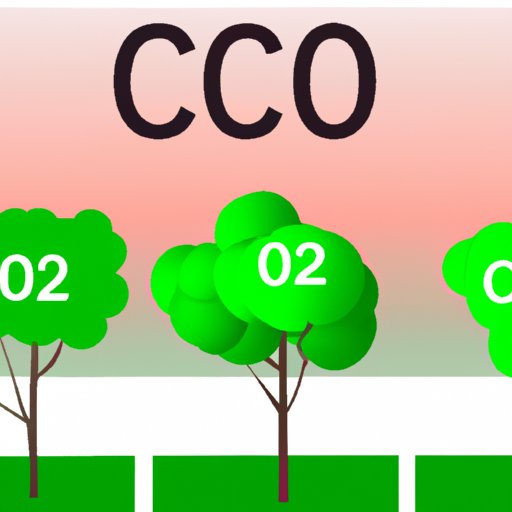Introduction
Carbon dioxide (CO2) is one of the most important molecules in the Earth’s atmosphere. It plays a crucial role in regulating the temperature of our planet and has a direct effect on our climate. Understanding the science behind CO2 is essential for recognizing its impact on our environment and taking measures to reduce emissions.
Exploring the Science Behind Carbon Dioxide (CO2)
CO2 is a naturally occurring molecule composed of one carbon atom and two oxygen atoms. It is colorless, odorless, and non-toxic. It exists in the air as a gas and is also found dissolved in water and in living organisms. The concentration of CO2 in the atmosphere is measured in parts per million (ppm). According to the National Oceanic and Atmospheric Administration (NOAA), the average global concentration of CO2 in the atmosphere is currently over 410 ppm – a level higher than it has been at any point in the past 800,000 years.
Chemistry of CO2
CO2 is an important part of the carbon cycle, which describes how carbon moves between the atmosphere, land, oceans, and living things. Plants absorb CO2 from the atmosphere during photosynthesis, using it to make food and releasing oxygen as a byproduct. Animals then consume plants for energy, and when they respire, CO2 is released back into the atmosphere. In this way, CO2 is continually exchanged between the atmosphere and living things.
Sources and Sinks of CO2
The main source of CO2 in the atmosphere is human activity, such as burning fossil fuels for transportation and electricity production. Other sources include deforestation, agricultural activities, and industrial processes. On the other hand, natural processes such as photosynthesis, respiration, and absorption by the oceans act as “sinks” for CO2, removing it from the atmosphere.
How CO2 Affects Our Planet
Role of CO2 in Climate Change
CO2 is one of the main greenhouse gases that trap heat in the atmosphere and contribute to global warming. According to the Intergovernmental Panel on Climate Change (IPCC), rising levels of CO2 and other greenhouse gases are responsible for the current rate of global warming. As temperatures increase, melting ice caps and glaciers, sea level rise, extreme weather events, and other impacts of climate change become more likely.
Impact of CO2 on Plant Growth
CO2 is essential for plant growth, and higher concentrations of CO2 can actually help plants thrive. Studies have shown that increased concentrations of CO2 can lead to increased rates of photosynthesis, faster growth rates, and increased yields for some crops. However, too much CO2 can also be harmful, leading to decreased nutrient concentrations in the soil and reduced water use efficiency.
CO2 and Ocean Acidification
Rising levels of CO2 are also causing ocean acidification, a process in which the pH of the ocean decreases as it absorbs more CO2 from the atmosphere. This can have serious consequences for marine ecosystems, as many species of fish, corals, and other organisms are sensitive to changes in pH. Scientists have warned that ocean acidification could disrupt the entire marine food web, leading to significant losses in biodiversity.
What Can We Do to Reduce CO2 Emissions?
Given the potential impacts of rising CO2 levels, reducing emissions is essential for protecting the environment. There are several strategies that can help achieve this goal, including:
Energy Efficiency
Using energy-efficient appliances and equipment, improving building insulation, and utilizing renewable energy sources can all help reduce energy consumption and CO2 emissions.
Renewable Energy
Replacing fossil fuels with renewable energy sources such as solar, wind, and geothermal power can significantly reduce CO2 emissions.
Reforestation
Planting trees and restoring forests is another effective way to reduce CO2 emissions, as trees absorb CO2 from the atmosphere and store it in their biomass.
Carbon Capture and Storage
Carbon capture and storage (CCS) is a technology that captures CO2 from power plants and other industrial sources and stores it underground. Although CCS is still in the early stages of development, it has the potential to significantly reduce emissions from large-scale sources.
Conclusion
In conclusion, CO2 is an essential molecule in the Earth’s atmosphere, but rising levels due to human activity can have severe environmental consequences. Taking steps to reduce emissions, such as increasing energy efficiency, utilizing renewable energy sources, reforesting, and exploring carbon capture and storage technologies, is essential for protecting our planet.
(Note: Is this article not meeting your expectations? Do you have knowledge or insights to share? Unlock new opportunities and expand your reach by joining our authors team. Click Registration to join us and share your expertise with our readers.)
